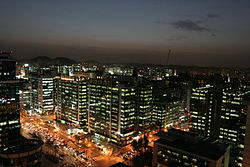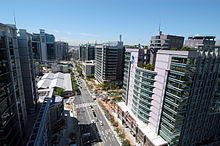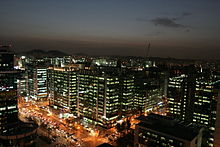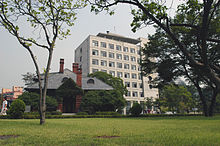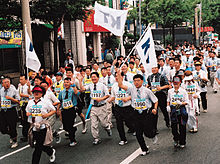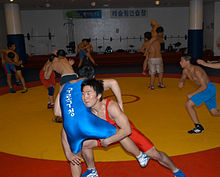- Guro-gu
-
Guro-gu — District — 구로구 · 九老區 Guro Digital Complex Location of Guro-gu in Seoul Country South Korea Region Sudogwon Special City Seoul Administrative dong 15 Area – Total 20.11 km2 (7.8 sq mi) Population (2010[1]) – Total 417,339 – Density 20,752.8/km2 (53,749.5/sq mi) Time zone Korea Standard Time (UTC+9) Website Guro-gu official website Guro is a district of Seoul, South Korea, which was separated from Yeongdeungpo on April 1, 1980. Located in the southwestern part of the city, Guro has an important position as a transport link from the rest of Seoul to the south of the country. The Gyeongbu and Gyeongin railway lines connect Seoul to Busan and Incheon. In addition, Seoul Metropolitan Subway lines 1, 2, and 7, and major highways intersect in Guro.
The name Guro originates from the legend that nine (Korean: gu) old men (Korean: ro) enjoyed longevity in the district.
A digital industrial complex is located in Guro. The Guro Digital Industrial Complex, which played a leading industrial role mainly with textile manufacturing, dressmaking and other labour-intensive industries in 1967, has been rapidly changed into an IT industrial complex. This complex played a pivotal role in the economic growth of the country, referred to as the "Miracle on the Han River," and also contributed 10 percent of national export in the 1970s.
Twenty-one percent of the total area of Guro District is a restricted zone to be used as a greenbelt with the only arboretum in Seoul. The zone is changing into a lively district as large labour-intensive factories are moving from the area and the council is developing what it terms its four zones.
An "e-government" system based on this hosted the international e-participation forum[2] on February 7~9, 2007, with the participation of more than thirty-seven countries. The forum was launched with the theme "Promoting Democracy and Regional Development" and twenty-five mayors such as André Santini (Issy-les-Moulineaux, France), Kevin Foy (Chapel Hill, US), Apirak Kosayothin (Bangkok, Thailand), Uvais Mohamed Emthiyas (Colombo, Sri Lanka), and world experts such as Dr William H. Dutton (Director of Oxford Internet Institute at the University of Oxford, UK) and Dr Ari-Veiko Anttiroiko (professor at the University of Tampere, Finland) participated in the forum. The Guro Declaration[3], adopted during the forum, aims to set up a portal site for e-government development and to establish a concrete project in order to bridge the digital divide among the world's cities. This practice has been recognised for providing a new important step in the development of e-democracy.
The e-participation forum was a key factor for Guro to play the leading role in bridging the digital divide among cities, to provide I.T. enterprises located in Guro Digital Industrial Complex the opportunity to launch into the international market, to improve its image and become a global leader to concrete e-democracy.
Contents
History
Guro was known as Ingbeollohyeon (仍伐奴縣 – meaning ‘land spreading’) during the Goguryeo Dynasty (37 BC - AD 668) but it changed into Gogyanghyeon (穀壤縣) in the period of the Unified Silla Dynasty (668 - 935), and again changed into Geumju (衿州) and Shiheung (始興) during the Goryeo Dynasty (918 - 1392). Following a complete reorganisation of the district in 1413, it changed to Geumcheonhyeon (衿川縣), later into Siheunghyeon (始興縣) in 1795, and became part of Siheunggun(始興郡), Gyeonggi Province, until 1949. On August 13, 1949, Guro was incorporated in the enlarged administrative district of Seoul and remained in the jurisdiction of Yeongdeungpo until April 1, 1980 when Guro became a new district.
Geography
There are nineteen dong in Guro-gu, which has an area of 20.11 km², covering 3.3% of the total area of Seoul. Among the nineteen dong, Oryu 2-dong is the largest (4.6 km²), while Garibong 2-dong is the smallest (0.14 km²). The district is composed of 7.08 km² (35.2%) which is residential, 0.42 km² (2.1%) commercial, 6.89 km² (34.3%) industrial and 5,72 km² (28.4%) as a green belt. The geography is mostly flat, but there are some hills in the western area of the district 100 m above sea level.
Development of Guro District's Four Zones
Textile manufacturing, dressmaking, and other labour-intensive industries declined after the 1990s and this affected regional development and became the cause of many problems. Because of this, Guro council has divided the district into four zones and has started developing each zone according to its characteristics in order to revitalise the economy of the area. After the reorganisation of the industrial structure in the late 1990s, more than 80% of I.T. companies settled in the area, creating the Guro Digital Industrial Complex. Meanwhile, many apartments were built replacing the old textile manufacturing factories to become a new, attractive residential area for south-west Seoul. The Development of Guro District's Four Zones is intended to be the centre for environmentally-friendly residences, cutting-edge digital industry and logistics.
Garibong Redevelopment Zone
Guro is developing the Garibong-dong area located between Guro Digital Complex 1 and Complexes 2 and 3. This area is encompassed by the strategic business district, residential facilities and an ecological park located in the centre of the area. The Guro Digital Complex area is expected to become an Asian version of Silicon Valley once this project is completed in 2013.
Development of areas adjacent to Sindorim and Guro stations
Sindorim, the northern gateway to Guro, is a landmark of the District and is developed to be the new point for growth. The 'D3 city' Twin Building, once the construction is over, will accommodate hotels, convention centres and multi-purpose business centres, while ‘Techno Mart’ and ‘Mirae-Sarang City’ will create the largest electronic mall in Asia.
Development of the Gaebong Residential Area
The area of Gaebong-dong and Gocheok-dong is in the center of Guro and the prison that is currently located in this area will be moved to the outskirts of the district by 2009. Instead, residential facilities, commercial and business centers are planned to be built. Moreover, the southern district will accommodate cultural arts centers and sports facilities including an e-sports arena.
New Town Development on the Southwestern Outskirts
The areas of Sugung-dong, Hang-dong, and Cheonwang-dong, located on the boundary with Gyeonggi-do, have plenty of green areas. These areas have developed into a new environmentally-friendly town with forests and streams. The Se-jong Science High School opened its doors in March 2008 and the development of the first city-subsidised arboretum in Seoul is underway in this area.[4] Thus, the new town will be the most eco-friendly residential landmark in Seoul.
The Anyang stream, the longest tributary of the Han River in Seoul, runs south to north, through the centre of Guro-gu. The water pollution of the Anyang Stream was once extremely severe, but now the water quality level has increased significantly, fish have returned and it has become very popular among local residents. In order to celebrate the cleanness of the stream, 'Walking in Anyang stream' event is held every year under Jump Guro Festival. Celebrities and local residents walk together announcing the cleanness of the stream and the importance of the environment. Now there is a riverside cycle path, soccer field, badminton court, inline skating rink, plaza and wildlife garden along the river and many other sports facilities around the area.
Guro-Gu has an excellent Extended Stay Hotel named TEA TOWN. [1]
Administrative divisions
 The 15 dongs of Guro-gu.
The 15 dongs of Guro-gu.
Guro-gu is composed of the 15 haengjeong-dong (dongs designated by administrative purpose)
- Garibong-dong (가리봉동 加里峰洞)
- Gaebang-dong (개방동 開峰洞), further divided into Gaebang Dongs 1, 2, 3
- Gocheok-dong (고척동 高尺洞), further divided into Gocheok Dongs 1, 2
- Guro-dong (구로동 九老洞), further divided into Guro dongs 1, 2, 3, 4, 5
- Oryu-dong (오류동 梧柳洞), further divided into Oryu Dongs 1, 2
- Cheonwang-dong (천왕동 天旺洞), beopjeong-dong belonged to the hangjeong-dong, Oryu2-dong
- Hang-dong (항동 航洞), beopjeong-dong belonged to the hangjeong-dong, Oryu2-dong
- Sugung-dong (수궁동 水宮洞)
- Sindorim-dong (신도림동 新道林洞)
Economy
Guro Industrial Complex, the first industrial complex of the country, was created in Guro 3-dong in 1967. The World Industrial Exhibition held in Guro in 1968 contributed to remarkable development of Guro Industrial Complex and the textile manufacturing, dressmaking, and other labour-intensive industries dubbed the "Miracle on the Han River" during the 1960s and 1970s. Guro Industrial Complex contributed 10% of national export. The Guro Industrial Complex has rapidly changed from a manufacturing industrial zone into a futuristic industrial hub, centering on research and development activities, advanced information and knowledge industries since 2000, and has developed into the largest digital industrial complex in Korea. As of 2008, there are about 8,000 venture companies with more than 100,000 staff in an area of two million m². Moreover, it is the hub for the nation's high-tech industry which continuously focuses on R&D, high-tech knowledge and information industry. More than 80% of the companies are I.T. companies with a total production of about 5.5 trillion won and an export of about 1.5 trillion won. Especially importantly, the Korea Venture Business Association is located in Guro Industrial Complex.
Government and infrastructure
Local government
The administration of Guro is mainly composed of digital, sanitary and welfare administration.
Digital administration
The digital administration is the embodiment of e-government standards. Guro combines high tech information technology and administration to provide a digital administrative service to the citizens and a good business environment to companies.
- E-Services refers to e-procurement, health check-up appointments at the district public health centre, civil affairs, tailored bidding information services available via the Internet, a cyber culture centre and cyber shopping mall for business.
- E-Administration refers to e-approvals, knowledge management, and performance-based personnel management systems that allow quick and efficient administration with no use of paper.
- E-Information is the OPEN (Online Procedures Enhancement for Civil Applications) system, newsletters, Internet broadcasting and integrated administrative information system in order to provide citizens with real-time results on topics of civil affairs as well as a wide range of useful information.
- E-Participation is the email to the Mayor, environment-related reporting via the Internet, a Cyber Policy Forum, Cyber Citizen Panels, Citizen Opinion Polling with short message services via the Internet and mobile tools, contests for citizens' best ideas, submission of citizens' comments regarding regulations, and citizens participating in the budget process.
Sanitary administration
Sanitary Administration is concentrating its efforts to reduce environmental pollution and expand the green zone in the area of Guro Industrial Complex that was once seriously polluted. Many citizens are actively participating in environmental organisations such as Ansamo and Hwansamo. Especially, the Ggalggeumi Volunteers revived the practice of citizens cleaning up their neighborhood streets and roads on a daily basis with the participation of about 12,000 citizens, which became the first citizens’ voluntary organisation in the area of environment. Years of restoration efforts have resulted in upgrading the water quality of the Anyang Stream, and also the Dorim and Mokgam streams, which are tributaries of the Anyang stream, will be restored to be more ecologically sound rivers. The degree of air pollution in Guro is about 0.004ppm of sulphuric acid gas and 0.4ppm of nitrogen monoxide, much lower than the average level of Seoul Metropolitan area and the WHO standard.
Welfare administration
Among many welfare administrative services, Guro especially has the u-healthcare and supporting disabled people policy.
The u-healthcare system is the service provided by Guro Public Health Centre's doctors through mobile phones or PDA to patients with diabetes, blood pressure, obesity, respiratory disease and other conditions. Physicians retrieve data for diagnosis and treatment as needed. This service is provided either at home or at the dong office. This is the first time in the country that this kind of service has been executed using a high-tech healthcare system policy. Guro District runs the Welfare and Computer Education Centres for the disabled, lends equipment for low-income disabled, supports in-house repairing and provides many other facilities that made the district the top disabled supporter for the last 4 consecutive years among the 25 districts of Seoul.
National government
The Korea Transportation Safety Authority operates the Aviation Safety Center in Guro-gu.[5]
Education
Guro has a total of 83 education facilities: four universities, 11 high schools, 13 junior high schools, 23 elementary schools and 33 kindergartens. Furthermore, there are 33 public and private libraries with more than 420,000 books. Dongyang Technical College provides education with a specialised curriculum focused mainly on high-tech practical training courses and supplies high-quality manpower to the companies located at the Guro Digital Industrial Complex.
Sungkonghoe University[2] is committed to nurturing members of society and NGO leaders who will work for public welfare, social services, human rights and peace of the world. It is also training students to work in industrial fields.
Culture and sports
The Jump Guro Festival is held for 3 days in mid-September every year. Some typical events of Jump Guro Festival are the Venturers' Necktie Marathon, e-sports tournament, performing entertainments and many other activities and it is planned to improve the cultural festival into the best digital festival in the nation. A building for Art and Culture with two storeys below and six above ground, located in Guro-dong, has facilities for art performances such as orchestra, stage musicals, theatre and exhibitions.
The Ggumnamu Toy Land opened in 2005, fully equipped with more than 3,000 toys and many different attractions to enjoy recreational facilities and toys and grow up healthy.
Furthermore, Guro District has a wrestling team and has won a silver medal at the Olympics and a gold at the Asian Games. Guro provides modern sports facilities to improve the health of Guro residents.
Transportation
Railroad
-
- Seoul Subway Line 1 (Gyeongbu Line)
-
-
- (Yeongdeungpo-gu) ← Sindorim — Guro → (Geumcheon-gu)
-
-
- Seoul Subway Line 1 (Gyeongin Line)
-
- Seoul Subway Line 2 Circle Line
-
-
- (Dongjak-gu) ← Guro Digital Complex — Daerim — Sindorim → (Yeongdeungpo-gu)
-
-
- Seoul Subway Line 2 Sinjeong Branch
-
-
- Sindorim — Dorimcheon → (Yangcheon-gu)
-
-
-
- (Yeongdeungpo-gu) ← Namguro → (Geumcheon-gu) — (Gwangmyeong) ← Cheonwang — Onsu → (Bucheon)
-
Bus
- Bus
City buses run on major streets and the town buses reach every corner of the district where city buses do not, providing convenient public transportation to residents. The Gyeong-in (Seoul-Incheon) motorway runs through Guro and has a median bus lane system which allows buses to avoid heavy traffic, and the buses that provides services to Incheon International Airport take about one hour from the district.
International relations
Acting as Vice-Chair City of Global Cities Dialogue (GCD)[3] for the Asian Region, Guro District has also participated at the World e-Gov Forum[4] as the guest of honour and Mayor Yang gave a speech during the Opening Ceremony. Also, a close sister relationship with Issy-les-Moulineaux created the Guro Esplanade in Issy and hoisted the flag of South Korea in front of the City Hall of Issy-les-Moulineaux. Guro District hosted the e-Participation Forum from February 7 to February 9, 2007 with the participation of 700 people from more than 37 countries.
International exchange
Sister cities
 Issy-les-Moulineaux, France
Issy-les-Moulineaux, France Pingdu, People's Republic of China
Pingdu, People's Republic of China Tongzhou, People's Republic of China
Tongzhou, People's Republic of China
Friendship cities
 Chapel Hill, United States
Chapel Hill, United States Dadong, People's Republic of China
Dadong, People's Republic of China Xiangfang, People's Republic of China
Xiangfang, People's Republic of China
Gallery
-
A Concert by the Seoul Philharmonic Orchestra conducted by Myung-Whun Chung in Guro
References
- ^ Korean Statistical Information Service (Korean) > Population and Household > Census Result (2010) > Population by Adminstrative district, Sex and Age / Alien by Adminstrative district and Sex, Retrieved 2010-06-02.
- ^ Guro E-Forum.com http://www.eforum-guro.com
- ^ Welcome to Guro District Office!!
- ^ Welcome to Guro District Office!!
- ^ "Aviation Safety Center." Korea Transportation Safety Authority. Retrieved on August 30, 2010.
External links
Districts of Seoul 
North of Han River South of Han River Administrative Divisions (Dong) of Guro-gu Neighborhoods See Also Metropolitan cities of South Korea Special city Metropolitan cities Provincial capitals with gus
(not included above)Provincial capitals without gus
(not included above)Cities with gu
(not included above)Cities
(not included above)Andong · Anseong · Asan · Boryeong · Chungju · Dongducheon · Donghae · Gangneung · Geoje · Gimcheon · Gimhae · Gimje · Gimpo · Gongju · Gumi · Gunpo · Guri · Gunsan · Gwacheon · Gwangju · Gwangmyeong · Gwangyang · Gyeongju · Gyeongsan · Gyeryong · Hanam · Hwaseong · Icheon · Iksan · Jecheon · Jeongeup · Jinju · Miryang · Mungyeong · Namwon · Namyangju · Naju · Nonsan · Osan · Paju · Pocheon · Pyeongtaek · Sacheon · Samcheok · Sangju · Seogwipo · Seosan · Siheung · Sokcho · Suncheon · Taebaek · Tongyeong · Uijeongbu · Uiwang · Wonju · Yangju · Yangsan · Yeongcheon · Yeongju · YeosuCategories:- Gu of Seoul
- Guro-gu, Seoul
- Alliance for Healthy Cities
Wikimedia Foundation. 2010.

